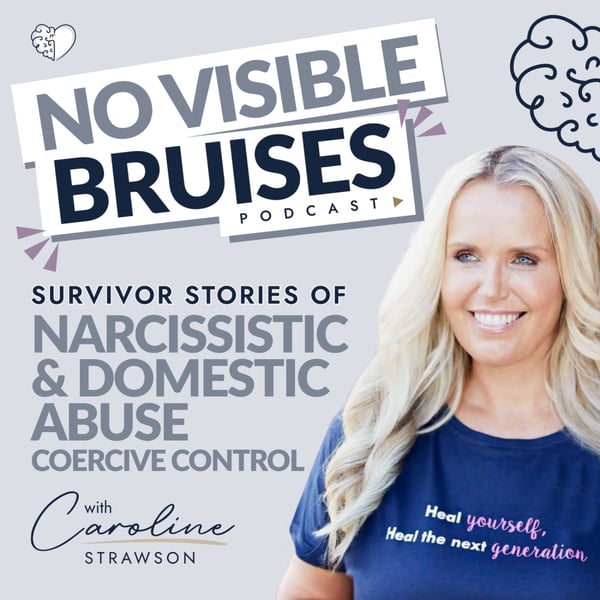Narcissistic Abuse & Polyvagal Theory
Trauma & Narcissism Redefined
Caroline Strawson
4.8 • 701 Ratings
🗓️ 31 August 2021
⏱️ 10 minutes
🧾️ Download transcript
Summary
In this episode, we will analyse narcissistic abuse from the polyvagal theory perspective. We’ll use this theory, remarkably well explained by Deb Dana, to understand how our nervous system responds to abuse, and use that knowledge to lift and remove the shame and guilt attached to those reactions.
What You Will Learn In This Episode:
- What is the polyvagal theory, and how the ladder analogy can help us to better understand our response to abuse
- What are the sympathetic, dorsal vagal, and ventral vagal responses of our system, and what they mean
- How triggers affect our "position" on the trust ladder
Understanding how and why we react to abuse is the first step to acknowledging that we are not weak and powerless, and that what is happening is not our fault. We need to get curious about what our system "sees," and what it is trying to protect us from.
Resources:
- Join my Narcissistic Trauma Recovery Programme™
https://go.carolinestrawson.com/heal-the-trauma-of-narcissistic-abuse
- Join my Facebook group at https://www.facebook.com/groups/thriveafternarcissisticabuse
- Connect with me on Instagram: https://www.instagram.com/carolinestrawson/
- My website: https://www.carolinestrawson.com/
Transcript
Click on a timestamp to play from that location
| 0:00.0 | Welcome to the narcissistic trauma recovery podcast. I'm Caroline Strawson and I'll be sharing with you |
| 0:09.5 | awareness, understanding and education about the devastating effects of narcissistic abuse to help you thrive. |
| 0:16.4 | I want you to know that I've been exactly where you are and I believe you. |
| 0:21.3 | And this show is all about taking you from trauma to transformation. |
| 0:30.5 | So in this episode, I want to talk to you about narcissistic abuse and polyvagal theory. |
| 0:37.1 | Now, don't worry, if you're kind of thinking, Caroline, |
| 0:39.0 | is this going to be a science lesson? It isn't. But I personally believe when you understand how |
| 0:44.7 | your nervous system works, it can really help lift that shame and guilt that you may feel around |
| 0:51.3 | your reactions in any given moment. And how I explain polyvagal theory to my clients |
| 0:57.8 | and in my narcissistic trauma recovery program is using my trustee ladder. So I want you to imagine now |
| 1:04.4 | that there's this ladder and this is how we're going to talk about your nervous system. |
| 1:08.7 | And Deb Dana really explains this so beautifully well, |
| 1:12.2 | and I adapt it to you when we're talking about narcissistic abuse and the trauma of narcissistic |
| 1:17.9 | abuse. So if you think about a ladder, at the top of the ladder is where we feel safe and connected. |
| 1:24.4 | Because think about it, if you were going to climb to the top of a ladder, you would only really do that if you felt confident to do so. So the top of the ladder represents within our |
| 1:33.3 | nervous system when we recognise there may be challenges, but we still feel safe and we still feel |
| 1:38.9 | connected. Now, what happens then is if we get a trigger, we move down that ladder into our fight and |
| 1:47.1 | flight element of our nervous system. And this is what we call our sympathetic nervous system. |
| 1:52.0 | So this is when our body becomes more flooded with cortisol, ready to either go into a fight |
| 1:58.0 | or run away and think about it from the animal kingdom. You know, that moment |
| 2:02.2 | where they get flooded with cortisol and adrenaline, that might be because there's a predator |
| 2:05.9 | chasing them and they've gone into the flight normally, they'll run away. And then if they get |
... |
Transcript will be available on the free plan in -1304 days. Upgrade to see the full transcript now.
Disclaimer: The podcast and artwork embedded on this page are from Caroline Strawson, and are the property of its owner and not affiliated with or endorsed by Tapesearch.
Generated transcripts are the property of Caroline Strawson and are distributed freely under the Fair Use doctrine. Transcripts generated by Tapesearch are not guaranteed to be accurate.
Copyright © Tapesearch 2025.

